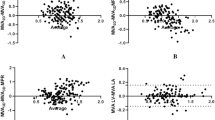Abstract
Mitral valve cleft (MVC) is the most common cause of congenital mitral regurgitation (MR). MVC may be located on the anterior or posterior leaflets. We evaluated children with moderate-to-severe MR using 3D transthoracic echocardiography (3DTTE) to diagnose MVC and determine the location, shape and size of MVC. Twenty-one patients under 18 years of age with moderate-to-severe MR without symptoms who were suspected of having MVC were included in the study. The patients’ history and clinical data were obtained from the medical records. 2D and 3D imaging were performed with a high-quality machine (EPIQ CVx). A vena contracta (VC) of colour Doppler regurgitated jet 3–7 and ≥ 7 mm defined moderate-to-severe regurgitation. An isolated anterior leaflet cleft (ALC) was detected in four patients, an isolated posterior leaflet cleft (PLC) in 12 patients, and both an ALC and PLC in five patients. VC was larger in patients with ALCs than PLCs (8.85 mm vs. 6.64 mm). Global LV longitudinal strain was better in the ALC group than in the PLC and both-posterior-and anterior MVC groups (− 24.7, − 24.3, and − 24%, respectively). Global circumferential strain was better in the ALC group (− 28.9%) and reduced in the bi-leaflet MVC group (− 28.6%). 3DTTE for visualisation of the MV can be successfully implemented in children and should be proposed during follow-up. AMVC and bi-leaflet MVC results in severe regurgitation and bi-leaflet MVC may be the reason for systolic dysfunction determined before clinically proven symptoms in the future.



Similar content being viewed by others
References
Tamura M, Menahem S, Brizard C (2000) Clinical features and management of isolated cleft mitral valve in childhood. J Am Coll Cardiol 35:764–770
Fraisse A, Massih TA, Bonnet D et al (2002) Cleft of the mitral valve in patients with Down’s syndrome. Cardiol Young 12:27–31
Abadir S, Fouilloux V, Metras D et al (2009) Isolated cleft of the mitral valve: distinctive features and surgical management. Ann Thorac Surg 88(3):839–843
Muraru D, Cattarina M, Boccalini F et al (2013) Mitral valve anatomy and function: new insights from three-dimensional echocardiography. J Cardiovasc Med (Hagerstown) 14:91–99
Nagueh SF, Smiseth OA, Appleton CP et al (2016) Recommendations for the evaluation of left ventricular diastolic function by echocardiography: an update from the American Society of Echocardiography and the European Association of Cardiovascular Imaging. J Am Soc Echocardiogr 29:277–314
Jones EC, Devereux RB, Roman MJ et al (2001) Prevalence and correlates of mitral regurgitation in a population-based sample (the Strong Heart Study). Am J Cardiol 87:298–304
Martínez-Sellés M, García-Fernández MA, Larios E et al (2009) Etiology and short-term prognosis of severe mitral regurgitation. Int J Cardiovasc Imaging 25:121–126
Zoghbi WA, Adams D, Bonow RO et al (2017) Recommendations for noninvasive evaluation of native valvular regurgitation: a report from the American Society of Echocardiography developed in collaboration with the Society for Cardiovascular Magnetic Resonance. J Am Soc Echocardiogr 30:303–371
Wyss CA, Enseleit F, van der Loo B et al (2009) Isolated cleft in the posterior mitral valve leaflet: a congenital form of mitral regurgitation. Clin Cardiol 32:553–560
Narang A, Adetia K, Weinert L et al (2018) Diagnosis of isolated cleft mitral valve using three-dimensional echocardiography. J Am Soc Echocardiogr 31(11):1161–1167
Di Segni E, Kaplinsky E, Klein HO (1992) Color Doppler echocardiography of isolated cleft mitral valve. Roles of the cleft and the accessory chordae. Chest 101(1):12–15.
Van Praagh S, Porras D, Oppido G et al (2003) Cleft mitral valve without ostium primum defect: anatomic data and surgical considerations based on 41 cases. Ann Thorac Surg 75(6):1752–1762
Kuhne M, Balmelli N, Tobler D, Linka A (2007) Isolated cleft of the posterior mitral valve leaflet. Int J Cardiol 122:e15
Fraisse A, Massih TA, Kreitmann B et al (2003) Characteristics and management of cleft mitral valve. J Am Coll Cardiol 42(11):1988–1993
Zhu D, Bryant R, Heinle J, Nihill MR (2009) Isolated cleft of the mitral valve: clinical spectrum and course. Tex Heart Inst J 36(6):553–556
Ring L, Rana BS, Ho SY, Wells FC (2013) The prevalence and impact of deep clefts in the mitral leaflets in mitral valve prolapse. Eur Heart J Cardiovasc Imaging 14(6):595–602
Mantovani F, Clavel MA, Vatury O et al (2015) Cleft-like indentations in myxomatous mitral valves by three-dimensional echocardiographic imaging. Heart 101(14):1111–1117
Suri MR, Schaff VH, Dearani JA et al (2006) Survival advantage and improved durability of mitral repair for leaflet prolapse subset in the current era. Ann Thorac Surg 82(3):819–827
Acknowledgements
We thank Associated Professor Dr. Reyhan Dedeoglu for her assistance in the strain measurements and 3D image acquisitions for this study.
Funding
There is no funding source.
Author information
Authors and Affiliations
Contributions
All three authors contributed to the design and data analysis and critically read the final manuscript.
Corresponding author
Ethics declarations
Conflict of interest
Author declares that they have no conflicts of interest to disclose.
Informed Consent
Informed consent was obtained from the parents or legal guardians of all individual participants included in the study.
Additional information
Publisher's Note
Springer Nature remains neutral with regard to jurisdictional claims in published maps and institutional affiliations.
Rights and permissions
Springer Nature or its licensor (e.g. a society or other partner) holds exclusive rights to this article under a publishing agreement with the author(s) or other rightsholder(s); author self-archiving of the accepted manuscript version of this article is solely governed by the terms of such publishing agreement and applicable law.
About this article
Cite this article
Bornaun, H., Katipoğlu, Ç. & Dedeoğlu, S. Revealing Mitral Valve Cleft Using Real-Time 3-Dimensional Echocardiography in Children with Mitral Regurgitation. Pediatr Cardiol 45, 660–665 (2024). https://doi.org/10.1007/s00246-023-03155-4
Received:
Accepted:
Published:
Issue Date:
DOI: https://doi.org/10.1007/s00246-023-03155-4




